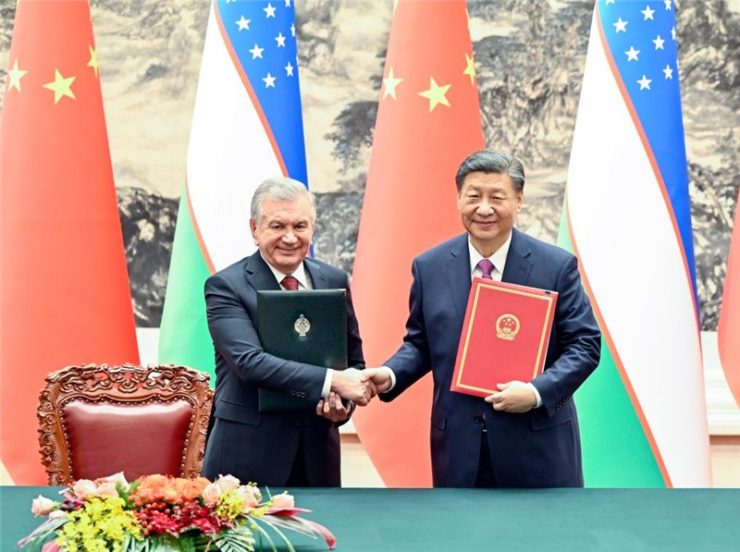
On January 24, 2024, Uzbek President Shavkat Miromonovich Mirziyoyev held talks with Chinese President Xi Jinping as part of his official visit to China. Meetings between the two states are not uncommon, having occurred four times in 2023 alone. This time, however, it is an event of historic proportions as the two countries have elevated their bilateral relations to an “all-weather all-round strategic partnership in a new era.” The meeting was attended by up to 25 high-ranking representatives from the People’s Republic of China and the Republic of Uzbekistan in an extended format. The meeting produced several important decisions, including the opening of the Export-Import Bank of China’s Central Asian office in Tashkent, the creation of the Uzbekistan-China Council of Regions, the hosting of a joint youth innovation forum, and more.
In addition, the parties emphasized the importance of an early start of practical work on the construction of the China-Kyrgyzstan-Uzbekistan railway. The opening of a new multimodal corridor Uzbekistan-Kazakhstan-China on the route Tashkent-Khorgos-Qingdao was also announced. This is part of the transport and infrastructure cooperation.
The two-fold increase in trade turnover between the two countries for 2023, which ensured that this indicator reached $14 billion (up to a quarter of Uzbekistan’s total foreign trade turnover) received positive assessment. That said, the parties expect to reach the $20 billion level in the near future. Simultaneously, the People’s Republic of China’s (PRC) accumulated investments in Uzbekistan have exceeded 14 billion dollars.
At the conclusion of the discussions, the Uzbekistani leader extended an invitation to the Chinese leader to make an official visit to Tashkent. As a result of the talks between the two leaders, 15 bilateral documents were signed.
The China-Uzbekistan investment forum, which took place in Shenzhen, the first free economic zone of the People’s Republic of China, located in the southern province of Guangdong, also yielded significant results and successes.
The President of Uzbekistan discussed with the head of China National Petroleum Corporation (CNPC) the possibility of constructing underground gas storage facilities and modernizing gas transportation systems in the country. Additionally, the leader of the republic held discussions with the head of the Chinese corporation CITIC, the chairman of the Silk Road Fund, the secretary of the Party Committee of Guangdong Province, the president of AIIB, and the head of the Eximbank of China. The joint project portfolio with the Eximbank of China alone amounts to 3.5 billion dollars. During the meeting with SANY’s management, the potential for constructing a new wind farm in Karakalpakstan and establishing a wind turbine manufacturing facility was discussed. Also, discussions were held with CSG management on ways to work together to reduce grid losses.
Attention was also given to the automobile industry. The President of Uzbekistan and the head of BYD, which became the world’s largest manufacturer of electric cars in 2023, launched a project to assemble electric cars in the Jizzak region. The plant has a capacity of 50,000 cars per year, with the potential to increase to 300,000. The parties also discussed plans to localize production of Chinese electric buses in the republic. Prior to Shavkat Mirziyoyev’s visit to China, an agreement was signed with Henan Suda, a Chinese company, to establish a network of charging stations for electric vehicles throughout Uzbekistan. The localization of production in this sector will be the first step towards the large-scale entry of Chinese companies into the market of electric-powered vehicles in Uzbekistan and throughout Central Asia.
The Forum also featured several notable presentations, including the following:
– A delegation from Tashkent discussed with the Chinese company Beijing North Bartholet Cableway Technology Co., Ltd. the prospect of building a cable public transport line in the capital of Uzbekistan.
-A delegation of Uztekstilprom discussed with Chinese colleagues the possibility of opening a Dongguan textile industrial zone in Uzbekistan.
– A delegation from Uzbekneftegaz JSC discussed with Chinese CNODS the prospects of creating super-deep wells in Uzbekistan. CNODS is already actively working in the field of gas production in the republic.
Alongside the business forum, two additional bilateral events took place: the first Uzbekistan-China interregional forum in Urumqi, and the Uzbek-Chinese educational forum in Beijing.
Thus, Shavkat Mirziyoyev’s visit to China highlighted several trends in bilateral relations and China’s foreign policy. First of all, as a result of the visit, Uzbekistan’s relations with the PRC in terms of trade, investment, infrastructure and status indicators came as close as possible to the PRC’s relations with Kazakhstan, the largest economy in Central Asia. In general, this scale and productivity of Shavkat Mirziyoyev’s visit speaks of the increasing attention of Central Asian countries to China, as well as of China’s priority interest in developing cooperation with them. The balanced development of various areas of bilateral cooperation, including politics, security, trade, investment, science and culture, is remarkable. All aspects of the relationship between the two countries appear to be moving forward in a coordinated and synchronized manner. The significant share of the “green” agenda in the relations between the two countries is curious and indicates its growing popularity in the world. The low proportion of bilateral mining projects may seem unusual, indirectly confirming the notion of Uzbekistan’s unique economic development model based on exporting high-value products rather than raw materials.
Boris Kushkhov, the Department for Korea and Mongolia at the Institute of Oriental Studies of the Russian Academy of Sciences, exclusively for the online magazine “New Eastern Outlook”
